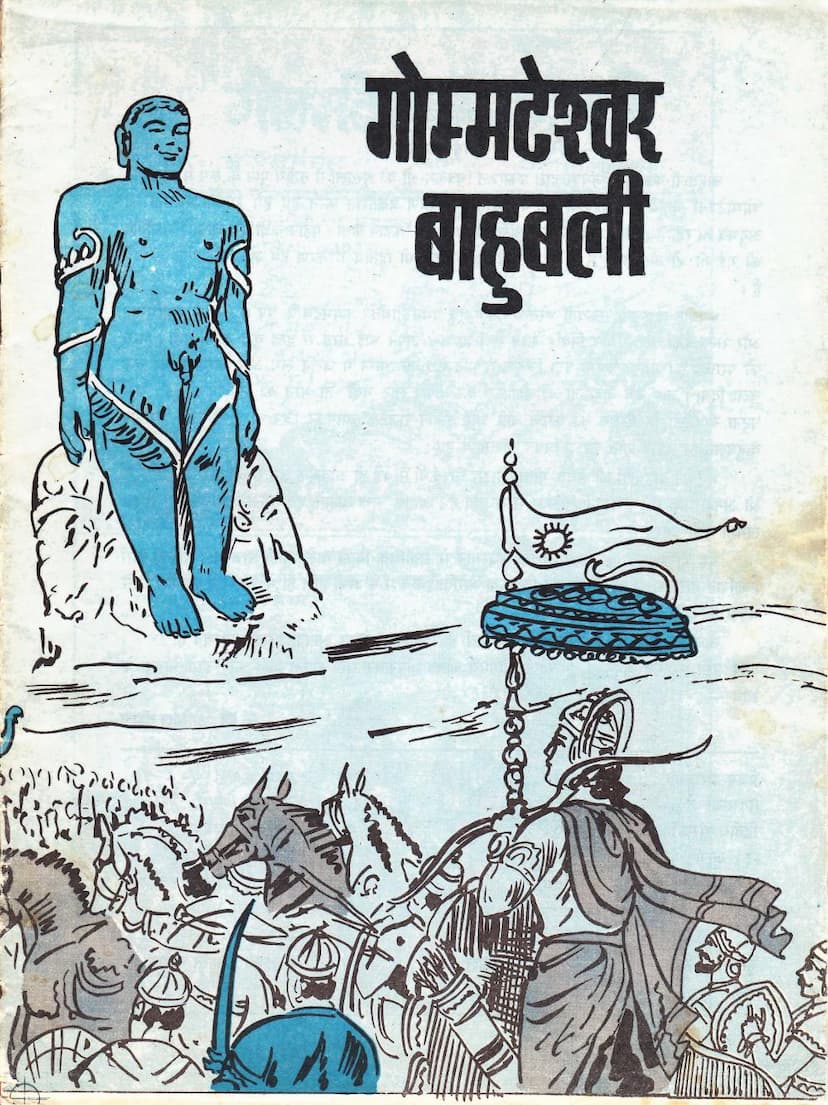Gommateshwar Bahubali
Added to library: September 1, 2025

Summary
Here's a comprehensive summary of the Jain text "Gommateshwar Bahubali" by Akhil Bansal, based on the provided pages:
Overview:
"Gommateshwar Bahubali" is a picture storybook published by Bahubali Prakashan, aimed at both children and adults. It recounts the inspiring life story of Lord Bahubali, a significant figure in Jainism, known for his renunciation and attainment of omniscience. The book highlights his lineage, his conflict with his brother Bharata, his path to detachment, and his ultimate liberation. The text emphasizes the Jain principles of renunciation, non-violence, and the pursuit of spiritual knowledge.
Key Narrative Points:
-
Introduction and Lineage: The book begins by introducing Lord Bahubali as the son of the first Tirthankara, Lord Rishabhdev, and the younger brother of Emperor Bharata. It places their story within the context of Bharat Kshetra, where the transition from the enjoyment era to the era of action occurred. King Nabhiraya and Queen Marudevi are mentioned as the parents of Lord Rishabhdev.
-
Lord Rishabhdev's Reign and Renunciation: Lord Rishabhdev married Yashaswati and Sunanda, who bore him 100 sons (including Bharata) and daughters. He was a wise ruler who imparted knowledge of various disciplines to his subjects and trained his sons in different arts and sciences. A pivotal moment in his life was witnessing the illusory nature of worldly pleasures and the impermanence of life, symbolized by the dancing nymph Neelanjana. This realization led him to renounce his kingdom and embrace asceticism.
-
The Rise of Emperor Bharata: Upon Lord Rishabhdev's renunciation, his eldest son, Bharata, inherited the kingdom. Bharata is credited with giving his name to the land of Bharat. The other sons also received kingdoms. Bharata, through his prowess and military might, embarked on a Digvijaya (conquest of all directions). He conquered various regions, receiving tribute and acknowledging his supreme sovereignty.
-
The Conflict with Bahubali: After his Digvijaya, Bharata returned to Ayodhya and discovered that his brothers, particularly Bahubali, had not acknowledged his Chakravarti (universal emperor) status. Bharata, driven by pride, sent a message demanding their submission. Bahubali, residing in Podanpur, saw through Bharata's ego and decided to challenge him.
-
The Dual (Dwandva Yuddha): To resolve the conflict and determine superiority, a dual combat was decided between Bharata and Bahubali. This combat consisted of three stages:
- Drishti Yuddha (Eye Combat): A contest of unwavering gaze. Bahubali emerged victorious as Bharata's eyes grew tired.
- Jala Yuddha (Water Combat): A battle involving water. Bahubali again proved superior, overwhelming Bharata.
- Malla Yuddha (Wrestling Combat): The final and most intense stage. Bahubali, with immense strength, lifted Bharata and was about to throw him.
-
Bahubali's Renunciation and Asceticism: At the moment of victory, Bahubali realized the destructive nature of pride and the futility of fighting his elder brother. He understood that true strength lay not in conquest but in self-control. Instead of throwing Bharata, Bahubali showed immense respect and humility, proclaiming Bharata's victory. He then declared his own renunciation of worldly possessions and the burden of kingship, influenced by Bharata's humiliation and the fact that his own Chakra (the divine discus symbol of Chakravarti) did not manifest to aid him. Bahubali bestowed his kingdom upon his son, Mahabal, and embraced the life of a Digambara (sky-clad) ascetic, undergoing self-purification through rigorous penance.
-
Attainment of Kevala Jnana (Omniscience): Bahubali performed severe austerities, standing motionless for a year. During this time, vines grew around his limbs, and birds built nests on him, yet he remained undisturbed. Even gods and celestial beings were amazed by his devotion. However, his omniscience was delayed due to a subtle lingering attachment to the fact that he was standing on land ruled by Bharata. Upon realizing that the land belonged to no one and would not accompany him, this last vestige of attachment was removed. He then attained Kevala Jnana, and the gods celebrated with a rain of flowers and music.
-
The Legacy of the Gommateshwar Idol: The book concludes by mentioning the historical significance of the Gommateshwar idol. It states that in 981 CE, the Gang Dynasty's chief minister and general, Chamundaraya, inspired by his mother and guided by his guru Nemichandracharya, commissioned the construction of a 57-foot tall statue of Bahubali in Shravanabelagola, Karnataka. This statue, carved from a single rock, is a testament to Bahubali's renunciation and strength. The text also notes that the Mahamastakabhishekam (grand consecration ceremony) of the Bahubali idol takes place approximately every 12 years and that numerous statues of Bahubali have been erected worldwide, symbolizing the path of renunciation for achieving peace and happiness.
Publisher's Note (Editorial Section):
The publisher expresses joy in releasing the second edition of "Gommateshwar Bahubali," which follows the success of their previous publications, "Kavivar Banarasidas" and "Kahani Katha: Maha Katha." They highlight that this picture storybook, illustrated by Anant Kushwaha, is engaging for children and has also been serialized in the popular children's magazine "Bal Hans." They announce their upcoming publication, "Acharya Shri Vidyanand," and extend wishes for readers to find peace and happiness by adopting a life of renunciation like Lord Bahubali.